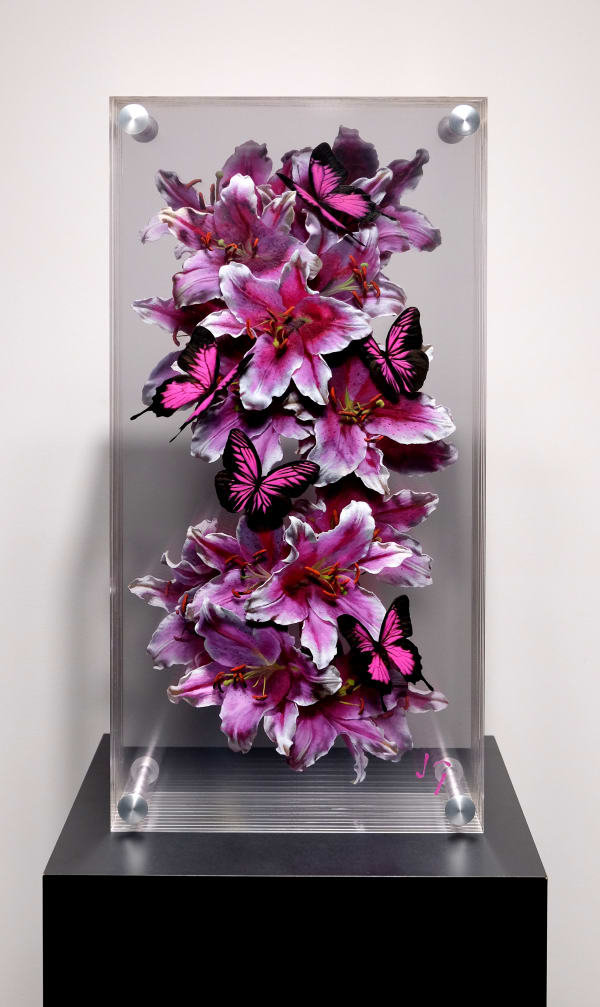James Galindo American, b. 1984
The sophistication of James Galindo’s work belies his relatively young age of 28. The oil paintings and drawings of women that make up the core of the Los Angeles-based artist’s oeuvre depict far more than the female form; they capture the longing, desire, fragility, and empathy so central to life itself. His anonymous subjects are not merely sitters we see through the artist’s eye, but living, breathing women whose subtle expressions, luminous, sculpted forms, and inner dialogues convey a physical and psychological presence.
Raised in Palm Springs, CA, Galindo, who has been drawing since he was a child, received his MFA from the Laguna Academy of Art and Design, where he now teaches drawing and painting. An astute observer of art history, he draws on the rich traditions of portraiture and the nude, from Gustave Courbet to John Singer Sargent. His dramatic use of light, painterly brushwork, and earthy palette, accented with jewel tones, evokes French and Dutch Old Masters.
But Galindo’s canvases are his own. Where some artists become slaves to the past, Galindo frees it and brings it to life in the 21stcentury. His presence can be felt in each work, through the energy of his brushstrokes or oil crayon, the rawness of the edges of the canvas, often left unfinished, and the tactility of the paint. These are not merely windows onto a timeless, intimate scene, as many classical nudes are, but carefully crafted and tenderly wrought records of the artist at work as he fuses paint to canvas. His nudes often emerge from an indistinct ground, a breath of life inhabiting each. He guides the viewer’s eye to focus on the face and torso—a kind of symbolic core of each figure, and each canvas. And through his careful brushwork he articulates enough detail to read each face while retaining a sense of dreamy softness. His women are almost ethereal, yet his layers of oil paint achieve a tangible materiality that brings them back to this world. Each figure is certainly individualistic in appearance, but what emerges is a universal moment recognizable to all.
The sophistication of James Galindo’s work belies his relatively young age of 28. The oil paintings and drawings of women that make up the core of the Los Angeles-based artist’s oeuvre depict far more than the female form; they capture the longing, desire, fragility, and empathy so central to life itself. His anonymous subjects are not merely sitters we see through the artist’s eye, but living, breathing women whose subtle expressions, luminous, sculpted forms, and inner dialogues convey a physical and psychological presence.
Raised in Palm Springs, CA, Galindo, who has been drawing since he was a child, received his MFA from the Laguna Academy of Art and Design, where he now teaches drawing and painting. An astute observer of art history, he draws on the rich traditions of portraiture and the nude, from Gustave Courbet to John Singer Sargent. His dramatic use of light, painterly brushwork, and earthy palette, accented with jewel tones, evokes French and Dutch Old Masters.
But Galindo’s canvases are his own. Where some artists become slaves to the past, Galindo frees it and brings it to life in the 21stcentury. His presence can be felt in each work, through the energy of his brushstrokes or oil crayon, the rawness of the edges of the canvas, often left unfinished, and the tactility of the paint. These are not merely windows onto a timeless, intimate scene, as many classical nudes are, but carefully crafted and tenderly wrought records of the artist at work as he fuses paint to canvas. His nudes often emerge from an indistinct ground, a breath of life inhabiting each. He guides the viewer’s eye to focus on the face and torso—a kind of symbolic core of each figure, and each canvas. And through his careful brushwork he articulates enough detail to read each face while retaining a sense of dreamy softness. His women are almost ethereal, yet his layers of oil paint achieve a tangible materiality that brings them back to this world. Each figure is certainly individualistic in appearance, but what emerges is a universal moment recognizable to all.
-

Blooms and Brushstrokes
A Group Exhibition 11 Jul - 22 Sep 2024 Laguna Beach'Blooms and Brushstrokes' on view from July 11, 2024 through September 22, 2024. 326 Glenneyre Street Laguna Beach, CA (949) 497-4988 RSVP: info@dawsoncolefineart.comRead more -

LOVE + MODERN BEAUTY
30 Jan - 15 Feb 2021 Laguna BeachDawson Cole Fine Art is pleased to present 'LOVE + MODERN BEAUTY' from January 30- February 15, 2021. There’s something to be said about the holiday’s celebration of love, and...Read more




